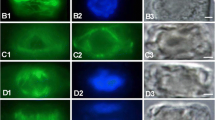Summary
Colchicine treatment ofFunaria caulonemata, usually does not inhibit initiation of a side branch or its incipient elongation but does prevent movement of chloroplasts and the nucleus into the outgrowth. After colchicine and after cytochalasin B treatment side branches are formed about at the normal age of the cells; because of the inhibition of the apical cell they arise at an abnormal position,i.e., not in the third but in the second cell of a filament. After D2O treatment the organelles are dislocated toward the basal cross wall. The site of side branch formation is then obviously determined by the position of the nucleus. Cells with an irreversibly reversed longitudinal polar axis can be found; by centrifugation in proximal direction the sites of side branch initiation likewise are displaced into the proximal region of the cell, especially if the remigration of the nucleus is inhibited by colchicine. High concentrations of Ca2+ ions induce the formation of “side branch cells”, without any outgrowth. The calcium ionophore A 23 187 influences the position of the nucleus and of the side branch only slightly. After these various treatments intercalary divisions frequently occur. The role and interrelationship of the nucleus and peripheral cytoplasm in establishing and maintaining the polar axes, and the role of microtubules are discussed.
Similar content being viewed by others
References
Bardele, C. F., 1977: Comparative study of axopodial microtubule patterns and possible mechanisms of pattern control in the centrohelidian HeliozoaAcanthocystis, Raphidiophrys, andHeterophrys. J. Cell. Sci.25, 205–232.
Bopp, M., 1954: Ein Beitrag zur Differenzierung im Moosprotonema. Ber. dtsch. bot. Ges.67, 177–184.
—,Jahn, H., Klein, B., 1964: Eine einfache Methode, das Substrat wÄhrend der Entwicklung von Moosprotonemen zu wechseln. Rev. Bryol. Lichén.33, 219–233.
Bünning, E., 1958: PolaritÄt und inÄquale Teilung des pflanzlichen Protoplasten. Protoplasmatologia VIII, 9a. Wien: Springer.
Burgess, J., 1970: Interactions between microtubules and the nuclear envelope during mitosis in a fern. Protoplasma71, 77–89.
Chen, T.-H., Jaffe, L. F., 1979: Forced calcium entry and polarized growth ofFunaria spores. Planta144, 401–406.
Faivre-Baron, M., 1978: Etude des mécanismes de corrélations d'inhibition chez le jeune gamétophyte duGymnogramme calomelanos L. Biochem. Physiol. Pfl.172, 79–91.
Fitting, H., 1950: über die Umkehrung der PolaritÄt in den Sporenkeimlingen einiger Laubmoose. Planta37, 635–675.
Gourgaud, M., 1968: Action comparée du chloramphénicol et de la colchicine sur la croissance et la ramification du protonéma deCeratodon purpureus (Brid.) cultivéin vitro à l'obscurité. Bull. Soc. Bot. Fr., Mém115, 202–207.
—, 1968 b: étude comparée de la croissance et de la ramification d'un protonéma deLeptobryum pyriforme (Schimp.) issu soit d'une spore soit de cellules protonématiques isolées. Rev. Bryol. Lichén.36, 155–161.
Heath, I. B., Heath, M. C., 1978: Microtubules and organelle movements in the rust fungusUromyces phaseoli var.vignae. Cytobiol.16, 393–411.
Jaffe, L. A., Weisenseel, M. H., Jaffe, L. F., 1975: Calcium accumulations within the growing tips of pollen tubes. J. Cell Biol.67, 488–492.
Knoop, B., 1973: Untersuchungen zum Regenerationsmechanismus beiFunaria hygrometrica Sibth. I. Die Auslösung der Caulonemaregeneration. Z. Pflanzenphysiol.70, 22–33.
—, 1976: Untersuchungen zum Regenerationsmechanismus beiFunaria hygrometrica Sibth. III. Auslösung durch Inhibitoren und Unterdrückung der apikalen Dominanz. Z. Pflanzenphysiol.77, 350–358.
Larpent-Gourgaud, M., 1969: Déterminisme de la ramification et du bourgeonnement chez le protonéma de Bryales. Ann. Sci. Nat., Bot. Biol. Végét. 12. Sér.10, 1–102.
Ootaki, T., 1963: Modification of the developmental axis by centrifugation inPteris vittata. Cytologia28, 21–29.
Quatrano, R. S., 1978: Development of cell polarity. Annu. Rev. Pl. Physiol.29, 487–510.
Schechter, V., 1935: The effect of centrifuging on the polarity of an alga,Griffithsia bornetiana. Biol. Bull.68, 172–179.
Schmiedel, G., 1978: ZellpolaritÄt und Verzweigung im Caulonema vonFunaria hygro-metrica Sibth. Thesis, Heidelberg.
-Schnepf, E., 1979 a: Polarity and growth of caulonema tip cells of the moss,Funaria hygrometrica. Planta (submitted for publication).
— —, 1979 b: Side branch formation and orientation in the caulonema of the moss,Funaria hygrometrica: Normal development and fine structure. Protoplasma100, 367–384.
Tippit, D. H., Pickett-Heaps, J. D., 1974: Experimental investigations into morphogenesis inMicrasterias. Protoplasma81, 271–296.
Weisenseel, M. H., Nucitelli, R., Jaffe, L. F., 1975: Large electrical currents traverse growing pollen tubes. J. Cell Biol.66, 556–567.
Werz, G., 1974: Fine structural aspects of morphogenesis inAcetabularia. Int. Rev. Cytol.38, 319–367.
Author information
Authors and Affiliations
Rights and permissions
About this article
Cite this article
Schmiedel, G., Schnepf, E. Side branch formation and orientation in the caulonema of the moss,Funaria hygrometrica: Experiments with inhibitors and with centrifugation. Protoplasma 101, 47–59 (1979). https://doi.org/10.1007/BF01293434
Received:
Accepted:
Issue Date:
DOI: https://doi.org/10.1007/BF01293434



